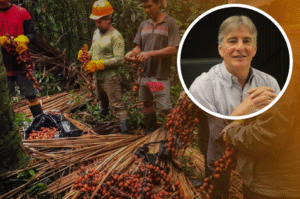Aguaje is one of the most emblematic fruits of the Peruvian Amazon. Beyond its high nutritional value, it represents a source of cultural identity and economic livelihood for thousands of families. It grows in aguajales—essential wetlands that regulate the climate, store carbon, and host unique biodiversity.
In the city of Iquitos, the capital of Loreto, around 8,200 tons of aguaje are consumed annually (Peruvian Society for Environmental Law, 2024). This steady demand places significant pressure on the aguajales and on the communities that depend on the fruit.
The traditional harvesting method, which involves cutting down female palms, is compromising the natural regeneration of the resource. This practice threatens not only the biodiversity of the wetlands, but also the future economic well-being of their inhabitants. Promoting sustainable practices such as palm climbing instead of cutting is not only possible—it is urgent. It represents the path to ensure that aguaje remains a source of life, culture, and development for the Amazon.

Recognizing this need, between March and July, the Productive Projects team of Green Gold Forestry (GGF), led by Engineer Sandro Soplin, conducted a series of training sessions entitled “Climbing Aguaje Palms and Good Harvesting Practices”, promoting the responsible use of this vital Amazonian resource.
The training sessions were directed at the native communities of San Felipe, Chambira, Santa María de Loreto, Patria Nueva, and Copal Urco, with the participation of 31 people—including 12 women—who stood out for their commitment and leadership.
The sessions focused on techniques such as climbing, which allows fruit to be collected without harming the palm trees, ensuring sustainable harvests year after year. Unlike felling, which requires at least eight years for a new palm to grow and produce fruit again, climbing helps preserve the ecosystem while improving local incomes in both the short and long term.
In addition to the technical component, the training included sessions on the legal framework for the sustainable use of aguaje and guidance on how to complete the Forest Transport Guide (GTF), a key tool to ensure resource traceability and legal compliance.
GGF provided specialized technical assistance and all the necessary equipment for the training. The initiative also benefited from the valuable support of representatives from GERFOR and OSINFOR, who joined efforts to strengthen a formal and responsible forest management aligned with current regulations.
Through this initiative, Green Gold Forestry reaffirms its commitment to Amazonian sustainability, responsible forest stewardship, and the empowerment of local communities.








